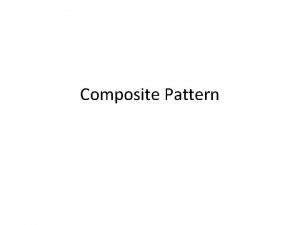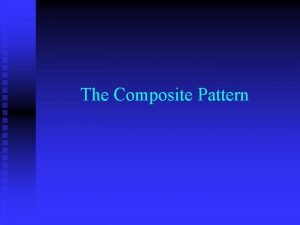Composite Design Pattern CECS 277 Fall 2017 Mimi









![class Composite. Pattern { public static void main(String[] args) { } } Composite england class Composite. Pattern { public static void main(String[] args) { } } Composite england](https://slidetodoc.com/presentation_image_h2/f1844481e5fa2403b163b1a77d6cedd9/image-10.jpg)





![public class Window { Button[] buttons; Menu[] menus; Text. Area[] text. Areas; Widget. Container[] public class Window { Button[] buttons; Menu[] menus; Text. Area[] text. Areas; Widget. Container[]](https://slidetodoc.com/presentation_image_h2/f1844481e5fa2403b163b1a77d6cedd9/image-16.jpg)

![public class Window { Widget[] widgets; Widget. Container[] containers; public void update() { if public class Window { Widget[] widgets; Widget. Container[] containers; public void update() { if](https://slidetodoc.com/presentation_image_h2/f1844481e5fa2403b163b1a77d6cedd9/image-18.jpg)



- Slides: 21

Composite Design Pattern CECS 277 Fall 2017 Mimi Opkins

The Composite Pattern • The Composite Pattern allows you to compose objects into tree structures to represent whole-part hierarchies. • Composite lets clients treat individual objects and composition of objects uniformly.

Motivation • A Composite is an object designed as a composition of one-ormore similar objects (components) all exhibiting similar functionality. – The key concept is that you can manipulate a single instance of the object just as you would a group of them. • The Composite pattern is useful in designing a common interface for both individual and composite components so that client programs can view both the individual components and groups of components uniformly. • Use to: – build part-whole hierarchies; – construct data representation of trees; – when you want your clients to ignore the difference between compositions of objects and individual objects.

Definition

Structure

Composite Pattern Participants • Component: – declares the interface for object composition – implements default behavior – declares an interface for accessing and managing the child components • Leaf : – represents leaf objects in the composition • Composite: – defines behavior for components having children – stores child components – implements child-related operations to the Component interface • Client: – manipulates objects in the composition through the Composite interface

Structural Code import java. util. *; interface Component { public String default. Method(); public Array. List<Component> get. Children(); public boolean add. Component(Component c); public boolean remove. Component(Component c); }

class Composite implements Component { private String id; private Array. List<Component> components = new Array. List<Component>(); public Composite(String identification { id = identification; } public String default. Method() { String s = "(" + id + ": "; for (Component child : get. Children()) s = s + " " + child. default. Method(); return s + ")"; } public Array. List<Component> get. Children(){ return components; } public boolean add. Component(Component c){ return components. add(c); } public boolean remove. Component(Component c){return components. remove(c); } }

class Leaf implements Component { private String id; public Leaf(String identification) { id = identification; } public String default. Method() { return id; } public Array. List<Component> get. Children() { return null; } public boolean add. Component(Component c) { return false; } public boolean remove. Component(Component c) { return false; } }
![class Composite Pattern public static void mainString args Composite england class Composite. Pattern { public static void main(String[] args) { } } Composite england](https://slidetodoc.com/presentation_image_h2/f1844481e5fa2403b163b1a77d6cedd9/image-10.jpg)
class Composite. Pattern { public static void main(String[] args) { } } Composite england = new Composite("England"); Leaf york = new Leaf("York"); Leaf london = new Leaf("London"); england. add. Component(york); england. add. Component(london); england. remove. Component(york); Composite france = new Composite("France"); france. add. Component(new Leaf("Paris")); Composite europe = new Composite("Europe"); europe. add. Component(england); europe. add. Component(france); System. out. println( europe. default. Method() );

Reasons/Consequences • Defines class hierarchies • Simple Clients – Doesn’t know/care whether dealing with leaf or composite class – Uniform treatment of composite & individual object • Easier to add new components – New composites or leaves work automatically • Can make design over general – Sometimes want a composite to have only certain components • Need run-time checks • Sharing components to reduce space when there is more than one parent is difficult

Implementation Issues • A composite object knows its contained components. – Should components maintain a reference to their parent component ? • Depends on application • Where should the child management methods (add(), remove(), get. Child()) be declared? – In the Component class: • gives transparency, since all components can be treated the same. • But it's not safe, since clients can try to do meaningless things to leaf components at run-time. – In the Composite class: • gives safety, since any attempt to perform a child operation on a leaf component will be caught at compile-time. • But we lose transparency, since now leaf and composite components have different interfaces.

Transparent vs. Safe

More Implementation Issues • Should Component maintain the list of components that will be used by a composite object? • That is, should this list be an instance variable of Component rather than Composite? – Better to keep this part of Composite and avoid wasting the space in every leaf object • Is child ordering important? – Depends on application • Who should delete components? – Not a problem in Java! The garbage collector will come to the rescue! • What's the best data structure to store components? – Depends on application

Example • A GUI system has window objects which can contain various GUI components (widgets) such as, buttons and text areas. A window can also contain widget container objects which can hold other widgets. • Solution 1: We designed all the widgets with different interfaces for "updating“ the screen. We would then have to write a Window update() method as follows:
![public class Window Button buttons Menu menus Text Area text Areas Widget Container public class Window { Button[] buttons; Menu[] menus; Text. Area[] text. Areas; Widget. Container[]](https://slidetodoc.com/presentation_image_h2/f1844481e5fa2403b163b1a77d6cedd9/image-16.jpg)
public class Window { Button[] buttons; Menu[] menus; Text. Area[] text. Areas; Widget. Container[] containers; public void update() { if (buttons != null) for (int k = 0; k < buttons. length; k++) buttons[k]. draw(); if (menus != null) for (int k = 0; k < menus. length; k++) menus[k]. refresh(); // Other widgets handled similarly. if (containers != null) } . . . } for (int k = 0; k < containers. length; k++ ) containers[k]. update. Widgets(); Solution 1

Solution 2 • We should always try to program to an interface, right? • So, let's make all widgets support the Widget interface, either by being subclasses of a Widget class or implementing a Java Widget interface. • Now our update() method becomes:
![public class Window Widget widgets Widget Container containers public void update if public class Window { Widget[] widgets; Widget. Container[] containers; public void update() { if](https://slidetodoc.com/presentation_image_h2/f1844481e5fa2403b163b1a77d6cedd9/image-18.jpg)
public class Window { Widget[] widgets; Widget. Container[] containers; public void update() { if (widgets != null) for (int k = 0; k < widgets. length; k++) widgets[k]. update(); if (containers != null) for (int k = 0; k < containers. length; k++ ) containers[k]. update. Widgets(); } }

Solution 3 – The Composite Pattern Now the update method looks like: public class Window { Component[] components; public void update() { if (components != null) for (int k = 0; k < components. length; k++) components[k]. update(); } }

Summary • The Composite Pattern provides a structure to hold both the individual objects and composites. • The Composite Pattern allows clients to treat composites and individual objects uniformly. • A Component is any object in a composite structure. Components may be other composites or leaf nodes. • There are many design tradeoffs in implementing the Composite. You need to balance transparency and safety with your needs.

Credits Toni Sellarès Universitat de Girona
 Polymorphism animal example
Polymorphism animal example Opkins
Opkins Cecs 277
Cecs 277 Opkins
Opkins Cecs 277
Cecs 277 Cecs 277
Cecs 277 Moment of inertia composite shapes
Moment of inertia composite shapes Cecs 323
Cecs 323 Cecs 474
Cecs 474 Cecs 474
Cecs 474 Cecs 343
Cecs 343 Cecs 474
Cecs 474 Cecs 343
Cecs 343 277/480 bank
277/480 bank 120/208 wye wye bank
120/208 wye wye bank +277 isd code
+277 isd code 277 / 60
277 / 60 Op amp stability capacitive load
Op amp stability capacitive load 2017 dvhimss annual fall conference
2017 dvhimss annual fall conference Composite pattern making
Composite pattern making Composite pattern c
Composite pattern c Composite pattern making
Composite pattern making



































